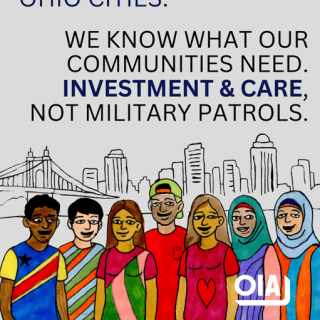On the far west side of Columbus, where never-ending prairie land was replaced with a never-ending stretch of corporate plaza hell, a young African American woman was assaulted. A witness who saw the assault and called 911 told the Free Press the Columbus police response was inadequate – something the Free Press has heard about the Columbus police for many years. The Columbus Division of Police (CPD) response seems to change depending on who the victim is and the nature of the crime.
The assault in many ways may be the result of a broken Columbus and how far it is from being fixed, even though Mayor Ginther and City Council seem more concerned about pushing growth – through Zone In, for instance – yet which is out of control.
A witness was in the parking lot of a McDonald’s on a recent Saturday morning and saw the young woman waiting for a COTA bus. The bus stop is unsheltered and too close to the four lanes of fast-moving traffic at the corners of Renner Road and Hilliard-Rome Road. The stop is across the street from a Walmart and its massive parking lot where transients and the houseless are a common sight.
The witness reported that a man approached the young woman at the bus stop and suddenly punched her in the jaw. The woman bolted across the four lanes of Hilliard-Rome Road, was chased by the man, but was able to duck into a nearby gas station. The witness quickly called 911, but while their report is immediately posted (pictured above) to the local Citizen app (“Where people protect each other”) the response by Columbus police was simply not fast enough and the officers seemingly uninspired.
Two police cruisers eventually appeared, nearly ten minutes after the 911 call. The officers also did not enter the parking lot of the gas station where the woman had fled. The police cruisers circled the area and left, all within a couple of minutes.
Should the “911 Right Response Unit” or the “Mobile Crisis Response Unit” have been sent out along with the police cruisers? The units were established earlier this decade by the City and given millions to put social workers and mental health professionals in the community to de-escalate scenes of crisis.
After the police vanished, the woman was able to slip out of the gas station, make her way back to the bus stop and jump on a COTA bus – all while the perpetrator was eyeing her from a short distance, the witness stated.
Local activist and former Free Press “Libby Award” winner Cynthia Brown, also the spokesperson for the Ohio Coalition To End Qualified Immunity, said, “It’s disheartening when such incidents occur, especially when lives are at risk. Unfortunately, domestic violence is a serious issue affecting many communities, including Columbus, Ohio.”
Brown, who is pushing for all law enforcement in Ohio to take more “de-escalation” training, points out that domestic violence disproportionately affects women, particularly Black women. Nationally, Black women face higher rates of intimate partner violence (IPV) compared to women of other racial backgrounds. According to the CDC, approximately 44 percent of Black women experience physical violence by an intimate partner during their lifetime, she said.
“The intersection of race and gender compounds the challenges faced by Black women in seeking help and protection,” said Brown. “The frustration with the police response is valid. Timely intervention is crucial in domestic violence cases. Empathy and sensitivity are essential qualities for law enforcement officers. When victims don’t receive the support they need, it perpetuates the cycle of violence. Advocacy groups and community leaders continue to push for better training and protocols to address domestic violence effectively.”
The amount of taxpayer money given to Columbus police and the new mental health response teams do not seem to have curtailed the number of continued complaints leveled against Columbus police for their lack of effort regarding certain crimes and victims. Of the City’s $1.20 billion 2024 general fund budget, $750 million is for public safety, which includes hiring an added 150-plus officers.
“The lack of empathy from the officers is [an observation] shared by many,” said Brown. “It underscores the need for ongoing efforts to improve police responses to domestic violence incidents. Let’s hope for a future where victims receive the help they deserve.”



